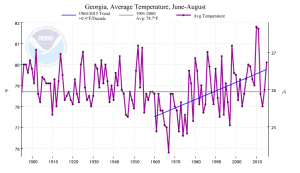I got a great question from Laura Griffeth, county extension agent for Webster County, Georgia, about a graph I showed in a post a while back on changes in summer temperature over time. Her question was “What happened in Georgia in the late 1960s for Georgia’s average temperature to be so low compared to other years? That’s pretty fascinating.”
Here’s the graph again.
Here’s the answer I wrote her:
That’s a great question! The low temperatures in the 1960s in Georgia are consistent with lower temperatures around the globe, not just a local phenomenon. If you look at similar graphs for global temperatures, you will see a reduction of temperature around that time period. Climatologists think there were several factors going on there. Globally, that was a time when declining temperatures were thought to reflect the fact that we were at the end of an interglacial period between ice ages, and that we were headed (very slowly) for the next ice age in 10,000 years or so. The articles in Time and Newsweek talking about temperatures getting colder over time and going into the next Ice Age were written in the early 1970s and reflect that. They are still quoted today as arguments against global warming, but really reflect changes happening on a much longer time scale than the warming we are seeing now.
There are at least two other factors which may be at play. One is that Mount Agung erupted in 1963, and we know that big tropical volcanic eruptions can reduce global temperatures for several years after the eruption (Krakatoa was one, and Pinatubo in 1992 was the most recent of these). So some of the cooling probably reflected the temporary cooling from volcanic aerosols. In the US, this was also the time period just prior to the passing of the Clean Air act, and the “human volcano” of dirty air was also probably reducing the sun’s energy reaching the surface, which reduced the temperatures too. The Clean Air Act was passed in 1970, and the air quality improved after that, making the atmosphere clearer and more transparent to sunlight.
While it is probably impossible to determine what exact combination of these factors produced the cooling (never mind that the ocean probably had some influence too, which is even harder to quantify), we are pretty sure that long-term orbital patterns which drive the ice ages, coupled with natural and man-made particles in the atmosphere which reduced the solar radiation reaching the ground, probably had a lot to do with the cooling back then.
If you’ve got a question about something that I posted on my blog (or something you’ve seen elsewhere, for that matter), please feel free to write me to ask about it. I won’t post it here unless I have your permission, though; it will be just between us. My email is pknox ‘at’ uga.edu.
